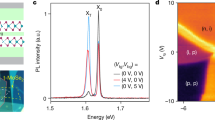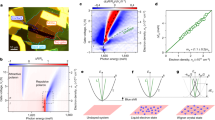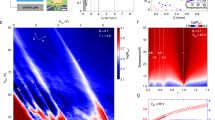Abstract
Strongly interacting electronic systems often exhibit a complicated phase diagram that results from the competition between different quantum ground states. One feature of these phase diagrams is the emergence of microemulsion phases, where regions of different phases self-organize across multiple length scales. The experimental characterization of these microemulsions can pose considerable challenges, as the long-range Coulomb interaction microscopically mingles with the competing states. Here we observe the signatures of the microemulsion between an electronic Wigner crystal and an electron liquid in a MoSe2 monolayer using cryogenic reflectance and magneto-optical spectroscopy. We find that the transition into this microemulsion state is marked by anomalies in exciton reflectance, spin susceptibility and umklapp scattering, establishing it as a distinct phase of electronic matter.
This is a preview of subscription content, access via your institution
Access options
Access Nature and 54 other Nature Portfolio journals
Get Nature+, our best-value online-access subscription
$32.99 / 30 days
cancel any time
Subscribe to this journal
Receive 12 print issues and online access
$259.00 per year
only $21.58 per issue
Buy this article
- Purchase on SpringerLink
- Instant access to full article PDF
Prices may be subject to local taxes which are calculated during checkout




Similar content being viewed by others
Data availability
Source data are provided with this paper. All other data are available from the corresponding authors upon reasonable request.
References
Spivak, B. Phase separation in the two-dimensional electron liquid in MOSFET’s. Phys. Rev. B 67, 125205 (2003).
Spivak, B. & Kivelson, S. A. Phases intermediate between a two-dimensional electron liquid and Wigner crystal. Phys. Rev. B 70, 155114 (2004).
Jamei, R., Kivelson, S. & Spivak, B. Universal aspects of Coulomb-frustrated phase separation. Phys. Rev. Lett. 94, 056805 (2005).
Lorenzana, J., Castellani, C. & Castro, C. D. Phase separation frustrated by the long-range Coulomb interaction. I. Theory. Phys. Rev. B 64, 235127 (2001).
Lorenzana, J., Castellani, C. & Di Castro, C. Phase separation frustrated by the long-range Coulomb interaction. II. Phys. Rev. B 64, 235128 (2001).
Ortix, C., Lorenzana, J. & Di Castro, C. Frustrated phase separation in two-dimensional charged systems. Phys. Rev. B 73, 245117 (2006).
Spivak, B. & Kivelson, S. A. Transport in two dimensional electronic micro-emulsions. Ann. Phys. 321, 2071–2115 (2006).
Emery, V. J. & Kivelson, S. A. Frustrated electronic phase separation and high-temperature superconductors. Physica C 209, 597–621 (1993).
Fäth, M. et al. Spatially inhomogeneous metal-insulator transition in doped manganites. Science 285, 1540–1542 (1999).
Dagotto, E., Hotta, T. & Moreo, A. Colossal magnetoresistant materials: the key role of phase separation. Phys. Rep. 344, 1–153 (2001).
Fogler, M. M., Butov, L. V. & Novoselov, K. S. High-temperature superfluidity with indirect excitons in van der Waals heterostructures. Nat. Commun. 5, 4555 (2014).
Skinner, B. Chemical potential and compressibility of quantum Hall bilayer excitons. Phys. Rev. B 93, 085436 (2016).
Wigner, E. On the interaction of electrons in metals. Phys. Rev. 46, 1002–1011 (1934).
Drummond, N. D. & Needs, R. J. Phase diagram of the low-density two-dimensional homogeneous electron gas. Phys. Rev. Lett. 102, 126402 (2009).
Kravchenko, S. V., Kravchenko, G. V., Furneaux, J. E., Pudalov, V. M. & D’Iorio, M. Possible metal-insulator transition at B = 0 in two dimensions. Phys. Rev. B 50, 8039–8042 (1994).
Yoon, J., Li, C. C., Shahar, D., Tsui, D. C. & Shayegan, M. Wigner crystallization and metal-insulator transition of two-dimensional holes in GaAs at B = 0. Phys. Rev. Lett. 82, 1744–1747 (1999).
Kravchenko, S. V. & Sarachik, M. P. Metal–insulator transition in two-dimensional electron systems. Rep. Prog. Phys. 67, 1–44 (2004).
Shashkin, A. A. & Kravchenko, S. V. Recent developments in the field of the metal-insulator transition in two dimensions. Appl. Sci. 9, 1169 (2019).
Hossain, M. S. et al. Anisotropic two-dimensional disordered Wigner solid. Phys. Rev. Lett. 129, 036601 (2022).
Falson, J. et al. Competing correlated states around the zero-field Wigner crystallization transition of electrons in two dimensions. Nat. Mater. 21, 311–316 (2022).
Ahn, S. & Das Sarma, S. Density-tuned effective metal-insulator transitions in two-dimensional semiconductor layers: Anderson localization or Wigner crystallization. Physical Review B 107, 195435 (2023).
Smoleński, T. et al. Signatures of Wigner crystal of electrons in a monolayer semiconductor. Nature 595, 53–57 (2021).
Zhou, Y. et al. Bilayer Wigner crystals in a transition metal dichalcogenide heterostructure. Nature 595, 48–52 (2021).
Tang, Y. et al. Simulation of Hubbard model physics in WSe2/WS2 moiré superlattices. Nature 579, 353–358 (2020).
Back, P. et al. Giant paramagnetism-induced valley polarization of electrons in charge-tunable monolayer MoSe2. Phys. Rev. Lett. 118, 237404 (2017).
Efimkin, D. K., Laird, E. K., Levinsen, J., Parish, M. M. & MacDonald, A. H. Electron-exciton interactions in the exciton-polaron problem. Phys. Rev. B 103, 075417 (2021).
Attaccalite, C., Moroni, S., Gori-Giorgi, P. & Bachelet, G. B. Correlation energy and spin polarization in the 2D electron gas. Phys. Rev. Lett. 88, 256601 (2002).
Knörzer, J. et al. Wigner crystals in two-dimensional transition-metal dichalcogenides: spin physics and readout. Phys. Rev. B 101, 125101 (2020).
Yarlagadda, S. & Giuliani, G. F. Spin susceptibility in a two-dimensional electron gas. Phys. Rev. B 40, 5432–5440 (1989).
Lifshitz, E. M. & Pitaevskii, L. P. Statistical Physics: Theory of the Condensed State (Elsevier Science, 2013).
Chakravarty, S., Kivelson, S., Nayak, C. & Voelker, K. Wigner glass, spin liquids and the metal-insulator transition. Philos. Mag. B 79, 859–868 (1999).
Kim, K.-S., Murthy, C., Pandey, A. & Kivelson, S. A. Interstitial-induced ferromagnetism in a two-dimensional Wigner crystal. Phys. Rev. Lett. 129, 227202 (2022).
Pomeranchuk, I. On the theory of liquid 3-He. Zh. Eksp. Teor. Fiz. 20, 919–926 (1950).
Saito, Y. et al. Isospin Pomeranchuk effect in twisted bilayer graphene. Nature 592, 220–224 (2021).
Rozen, A. et al. Entropic evidence for a Pomeranchuk effect in magic-angle graphene. Nature 592, 214–219 (2021).
Clark, B. K., Casula, M. & Ceperley, D. M. Hexatic and mesoscopic phases in a 2D quantum Coulomb system. Phys. Rev. Lett. 103, 055701 (2009).
Chui, S. T. & Tanatar, B. Impurity effect on the two-dimensional-electron fluid-solid transition in zero field. Phys. Rev. Lett. 74, 458–461 (1995).
Joy, S. & Skinner, B. Upper bound on the window of density occupied by microemulsion phases in two-dimensional electron systems. Phys. Rev. B 108, L241110 (2023).
Pudalov, V. M., Kuntsevich, A. Y., Gershenson, M. E., Burmistrov, I. S. & Reznikov, M. Probing spin susceptibility of a correlated two-dimensional electron system by transport and magnetization measurements. Phys. Rev. B 98, 155109 (2018).
Oganesyan, V., Kivelson, S. A. & Fradkin, E. Quantum theory of a nematic Fermi fluid. Phys. Rev. B 64, 195109 (2001).
Chowdhury, D., Orenstein, J., Sachdev, S. & Senthil, T. Phase transition beneath the superconducting dome in BaFe2(As1−xPx)2. Phys. Rev. B 92, 081113 (2015).
Kagan, M. Y., Kugel, K. I. & Rakhmanov, A. L. Electronic phase separation: recent progress in the old problem. Phys. Rep. 916, 1–105 (2021).
McGarrigle, E. C., Delaney, K. T., Balents, L. & Fredrickson, G. H. Emergence of a spin microemulsion in spin-orbit coupled Bose–Einstein condensates. Phys. Rev. Lett. 131, 173403 (2023).
Regan, E. C. et al. Mott and generalized Wigner crystal states in WSe2/WS2 moiré superlattices. Nature 579, 359–363 (2020).
Li, H. et al. Imaging two-dimensional generalized Wigner crystals. Nature 597, 650–654 (2021).
Xu, Y. et al. Correlated insulating states at fractional fillings of moiré superlattices. Nature 587, 214–218 (2020).
Skinner, B. & Shklovskii, B. I. Anomalously large capacitance of a plane capacitor with a two-dimensional electron gas. Phys. Rev. B 82, 155111 (2010).
Li, T. et al. Charge-order-enhanced capacitance in semiconductor moiré superlattices. Nat. Nanotechnol. 16, 1068–1072 (2021).
Xiang, Z. et al. Quantum melting of a disordered Wigner solid. Preprint at https://arxiv.org/abs/2402.05456 (2024).
Zondiner, U. et al. Cascade of phase transitions and Dirac revivals in magic-angle graphene. Nature 582, 203–208 (2020).
Acknowledgements
We acknowledge useful discussions with S. Kivelson, S. Das Sarma, A. Imamoglu, T. Smolenski, N. Leisgang and A. A. Zibrov. We thank T. Smolenski for sharing some of his unpublished data with us. We acknowledge support from AFOSR (FA9550-21-1-0216), the DoD Vannevar Bush Faculty Fellowship (N00014-16-1-2825 for H.P. and N00014-18-1-2877 for P.K.), NSF CUA (PHY-1125846 for H.P., E.D. and M.D.L.), Samsung Electronics (for H.P. and P.K.), NSF (PHY-1506284 for H.P. and M.D.L. and DGE-1745303 for E.B.), AFOSR MURI (FA9550-17-1-0002), ARL (W911NF1520067 for H.P. and M.D.L.) and DOE (DE-SC0020115 for H.P. and M.D.L. and DE-SC0022885 for Y.Z.). E.D. acknowledges support by the SNSF project no. 200021_212899. K.W. and T.T. acknowledge support from the JSPS KAKENHI (grant nos 19H05790, 20H00354 and 21H05233). The Flatiron Institute is a division of the Simons Foundation.
Author information
Authors and Affiliations
Contributions
H.P. and E.D. conceived the project. J.S., J.W., G.S., Y.Z. and E.B. fabricated the samples and designed and performed the experiments. I.E. and P.A.V. performed calculations. I.E., P.A.V., Y.Y., M.A.M., S.Z., A.J.M. and E.D. contributed to theoretical descriptions. J.S., J.W., I.E. and P.A.V analysed the data. T.T. and K.W. provided hBN samples. J.S., J.W., I.E., P.A.V., E.D. and H.P. wrote the paper with extensive input from the other authors. H.P., E.D., P.K. and M.D.L. supervised the project.
Corresponding authors
Ethics declarations
Competing interests
The authors declare no competing interests.
Peer review
Peer review information
Nature Physics thanks the anonymous reviewers for their contribution to the peer review of this work.
Additional information
Publisher’s note Springer Nature remains neutral with regard to jurisdictional claims in published maps and institutional affiliations.
Extended data
Extended Data Fig. 1 Optical image of device 1 and device 2.
a-b, Optical microscope image of (a) device D1 and (b) device D2. The MoSe2 monolayer regions are indicated by white dashed lines, and the solid red lines show the outline of the bottom gate electrode: (a) Pd/Au metal and (b) a few-layer graphite.
Extended Data Fig. 2 Umklapp features in another spot in the original device, D1, and in another device, D2.
Color map of the derivative of reflectance contrast spectra with respect to electron density at a base lattice temperature of 16 mK. A Lorentzian fitted exciton/RP peak was subtracted to emphasize the Umklapp features. The green line represents the fitted exciton/RP resonance energy, and the black dashed line indicates the expected resonance energy from umklapp scattering of excitons. Umklapp features in D1 (another spot from that shown in main Fig. 1) and in another device, D2, are shown in (a) and (b), respectively. Color map of the derivative of reflectance contrast spectra with respect to electron density, without subtracting the fitted exciton/RP Lorentzian in another spot in D1 (c) and in another device D2 (d).
Extended Data Fig. 3 Electron temperature estimation at low density under different incident light powers.
a-d, We plot the signal \(\widetilde{M}\) at the electron density of 0.30×1012 cm-2 under varying light powers: (a) 60 fW, (b) 320 fW, (c) 3.3 pW, and (d) 32 pW. From a fit using the Brillouin function, we estimate the electron temperature. The estimated electron temperatures are: (a) 80 mK, (b) 130 mK, (c) 180 mK, and (d) 350 mK.
Extended Data Fig. 4 Anomalies in the main excitonic properties.
a, Near the density of \({n}_{* }\) = 0.9×1012 cm-2, a noticeable discontinuity in the derivative of the exciton/RP resonance energy with respect to electron density, \(d{E}_{X}/{dn}\) is observed, signifying a change in the slope of the exciton/RP resonance energy. b, A pronounced slope change of the oscillator strength is observed near the density of \({n}_{* }\) = 0.9×1012 cm-2. Reflectance contrast spectra measurements were performed under a light power of 0.7 nW at a base lattice temperature of 16 mK. The black arrows on the top x-axis and black dashed lines indicate the characteristic densities, \({n}_{{\rm{WC}}}\) and \({n}_{* }\). Linear decrease of the oscillator strength upon doping is represented by the grey dashed line. The measured excitonic properties are a convolution of the intrinsic properties of its electronic environment and the details of how the exciton couples to the electrons. In particular, the exciton is sensitive to the electronic compressibility. Non-analytic behavior of the compressibility at the microemulsion-liquid transition should therefore be expected to lead to rapid changes in the excitonic properties.
Extended Data Fig. 5 Reduced spin susceptibility as a function of electron density at different temperatures.
a-f, The Curie susceptibilities in the Wigner crystal regime are indicated by grey dashed lines. The spin susceptibility between \({n}_{{\rm{WC}}}\) and \({n}_{* }\) aligns well with the colored dashed lines, representing intermediate density ranges that follow the lever rule. However, notable deviations from this linear behavior are observed in the vicinity of \({n}_{{\rm{WC}}}\) and \({n}_{* }\), signifying interface effects between the crystal and liquid regions. The boundaries of these density ranges are delineated by black vertical dashed lines, with these regions further emphasized by black arrows. The density ranges are quantified by the error bars in Fig. 4 of the main text. The determination of the transition near \({n}_{* }\) and the density ranges are described in Fig. S19.
Extended Data Fig. 6 Magnetic field dependence of n*.
a, Derivative of fitted exciton/RP resonance energy with respect to electron density for left circularly polarized reflectance contrast at various magnetic fields. The black dotted line marks the electron density (\({n}_{* }\)) that corresponds to the center of the jump in \(d{E}_{X}/{dn}\) at 9 T. b, Color maps showing left circularly polarized differential reflectance contrast are plotted as a function of electron density at various magnetic fields. The white dotted line marks the electron density at which the discontinuity (\({n}_{* }\)) occurs at 9 T.
Supplementary information
Supplementary Information
Supplementary Sections 1–10 and Figs. 1–19.
Source data
Rights and permissions
Springer Nature or its licensor (e.g. a society or other partner) holds exclusive rights to this article under a publishing agreement with the author(s) or other rightsholder(s); author self-archiving of the accepted manuscript version of this article is solely governed by the terms of such publishing agreement and applicable law.
About this article
Cite this article
Sung, J., Wang, J., Esterlis, I. et al. An electronic microemulsion phase emerging from a quantum crystal-to-liquid transition. Nat. Phys. 21, 437–443 (2025). https://doi.org/10.1038/s41567-024-02759-8
Received:
Accepted:
Published:
Issue date:
DOI: https://doi.org/10.1038/s41567-024-02759-8
This article is cited by
-
Electronic melt
Nature Physics (2025)
-
Optical signatures of interlayer electron coherence in a bilayer semiconductor
Nature Physics (2025)



